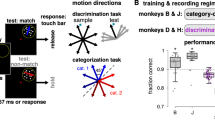Summary
Three monkeys with complete ablations of temporal-lobe limbic structures and three unoperated controls were compared in an automated testing apparatus for their ability to remember pictures presented between 1 and 180 seconds previously, as well as to learn picture discriminations in which successive trials with a given pair were separated by either 20 seconds or 24 hours. The operated animals were not impaired in picture discrimination learning under either condition and they were not impaired in picture recognition memory up to about 10 seconds. At 10 seconds and beyond, however, the operated animals showed rapid deterioration of picture memory. The results demonstrate that the limbic system's selective contribution to learning and retention uncovered initially with objects applies equally to pictures, this contribution being essential for recognition memory but not for discrimination habits. The results demonstrate further that, as in humans, temporal-lobe limbic structures are essential for recognition only when the retention test exceeds the immediate memory span of a few seconds.
Similar content being viewed by others
References
Cohen NJ, Squire LR (1980) Preserved learning and retention of pattern analyzing skill in amnesia: dissociation of knowing how and knowing that. Science 210: 207–209
Corkin S (1968) Acquisition of motor skill after bilateral medial temporal lobe excision. Neuropsychologia 6: 225–265
Gaffan D, Saunders RC, Gaffan EA, Harrison S, Shields C, Owen MJ (1984) Effects of fornix transection upon associative memory in monkeys: role of the hippocampus in learned action. Q J Exp Psychol 36B: 173–221
Gaffan D, Harrison S, Gaffan EA (1986) Visual identification following inferotemporal ablation in the monkey. Q J Exp Psychol 38B: 5–30
Malamut BL, Saunders RC, Mishkin M (1984) Monkeys with combined amygdalo-hippocampal lesions succeed in object discrimination learning despite 24-hour intertrial intervals. Behav Neurosci 98: 759–769
Milner B (1962) Les troubles de la memorie accompagnant des lesions hippocampiques bilaterales. Physiol L'Hippocampe 107: 257–272 (English translation in Glickman S, Milner PM (eds) (1965) Cognitive processes and the brain. Van Nostrand, Princeton)
Mishkin M (1978) Memory in monkeys severely impaired by combined but not separate removal of amygdala and hippocampus. Nature 273: 297–298
Murray EA (1987) Normal learning set formation in monkeys with combined ablation of the amygdaloid complex and hippocampal formation. Soc Neurosci Abstr 13: 206
Murray EA, Mishkin M (1984) Severe tactual as well as visual memory deficits follow combined removal of the amygdala and hippocampus in monkeys. J Neurosci 4: 2565–2580
Overman WH, Doty RW (1980) Prolonged visual memory in macaque and man. Neuroscience 5: 1925–1931
Overman WH, Ormsby GE, Mishkin M (1983) Effects of limbic lesions on picture recognition vs. picture discrimination learning in monkeys. Soc Neurosci Abstr 9: 27
Phillips RR, Mishkin M (1984) Further evidence of a severe impairment in associative memory following combined amygdalo-hippocampal lesions in monkeys. Soc Neurosci Abstr 10: 136
Phillips R, Malamut BL, Bachevalier J, Mishkin M (1988) Dissociation of the effects of inferior temporal and limbic lesions on object discrimination learning with 24-h intertrial intervals. Behav Brain Res 27: 99–107
Warrington EK, Weiskrantz L (1968) New method of testing long-term retention with special reference to amnestic patients. Nature 217: 972–974
Zola-Morgan S, Squire LR (1984) Preserved learning in monkeys with medial temporal lesions: sparing of motor and cognitive skills. J Neurosci 5: 1072–1085
Zola-Morgan S, Squire LR, Mishkin M (1982) The neuroanatomy of amnesia: amygdala-hippocampus versus temporal stem. Science 218: 1337–1339
Author information
Authors and Affiliations
Rights and permissions
About this article
Cite this article
Overman, W.H., Ormsby, G. & Mishkin, M. Picture recognition vs. picture discrimination learning in monkeys with medial temporal removals. Exp Brain Res 79, 18–24 (1990). https://doi.org/10.1007/BF00228870
Received:
Accepted:
Issue Date:
DOI: https://doi.org/10.1007/BF00228870




